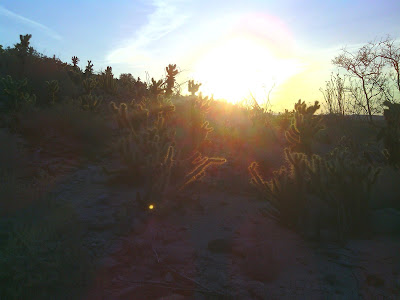Take in a deep breath of clean, dry air. Bask in the larger-than-life brilliance of the desert sun. Sink into the womblike comfort of warm spring water. At Agua Caliente Springs you can have your cake and eat it too- hike first, then enjoy a relaxing soak in the hot springs.
A county park has been established here in the midst of state park lands on the edge of Tierra Blanca Mountains. The big campground and nearby store, along with the pools, have made Agua Caliente Springs a focal point of activity in the southern Anza-Borrego area.
A splinter of the Elsinore Fault is responsible for the upwelling of warm, mineral-rich water. The Elsinore Fault passes through the Lake Elsinore area and Warner Springs, were hot springs are also found. There are three options for soaking at Agua Caliente Springs: a large indoor jacuzzi, where water is boosted to more than 100 degrees, a shallow 2 1/2 foot wading pool for the kiddos, and a deeper 5 1/2 foot pool that's perfect for cooling off on warmer days.
Agua Caliente Springs lies off Highway S-2, 27 miles northwest of Interstate 8 at Ocotillo, and 22 miles southeast of Highway 78.
Enjoying the day-use area and playing horse shoes.
Relaxing around camp.
Nap time in grandparent's tent.
Time for a stroll around camp.
My wife's brother, parked next to us.
My wife's uncle brought out his Jeep so I was bummed to not have mine.
The campground recently started putting in new cabins.
This was the RV/hookup area.
Hanging out with Aunty.
I didn't get a chance to hike this trail. Hopefully next time.
Random bench in the desert.
I'm just a desert hobo.
I was up early the next morning to hike a nearby trail.
A bunny stops by to say hi.
The wind had blown like crazy last night.
This was the beginning of Squaw Pond Trail near the park's entrance.
You wind over a low ridge, passing a spur trail leading to an overlook point a little higher on the ridge, then descend to a sandy wash in Squaw Canyon.
Turn left here and make your way past thickets of mesquite- vibrant green when leafing out in March, and festooned with creamy yellow-green flower spikes April through June.
The nutritious pealike pods of the mesquite ripen in September, and are eaten by various animals. Ahead lies Squaw Pond- a marshy area with several large willow trees and some small palm trees.
The path get narrower as you approach the trees.
At least one rattlesnake makes a living on the small furry creatures that come to drink here. Coyotes and bobcats also frequent this little oasis.
On the nearby hillsides you can admire the natural gardens of barrel and teddy bear cholla cactus.
There's really no pond per say, just an intermittent stream that you follow.
Almost back to camp.
After breakfast it was time to pack up.
Are we ready for another dip in the pool?
Good times with family.
After a quick dip in one of the cool outdoor pools we finished loading up the car and started making our way back home.
On the way out we made a stop at the Carrizo Badlands overlook. Hopefully we can get in one more trip out into the desert before the heat gets turned on full time.



























































































.jpg)
